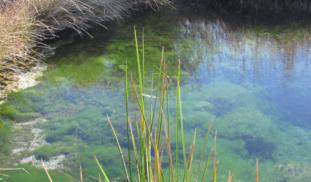Please wait...
About This Project
A network of underground aquifers provide a constant source of water to seeps within Ash Meadows in the heart of the Mojave Desert. These spring-fed aquatic habitats stand in stark contrast to the dry, desert conditions surrounding them. How unique is the algal flora of these isolated spring-fed seeps? We aim to understand the algal diversity of the aquatic habitats with Ash Meadows and the results of our study will provide valuable information for the future management of this unique system.
More Lab Notes From This Project

Browse Other Projects on Experiment
Related Projects
How do polar bears stay healthy on the world's worst diet?
Polar bears survive almost entirely on seal fat. Yet unlike humans who eat high-fat diets, polar bears never...
Uncovering hidden insect diversity associated with a likely undescribed gall-forming midge
Does a likely undescribed species of gall-forming midge (pers. comm. Ray Gagné) on Eriodictyon plants (Yerba...
Macrofungi of the California archipelago
The eight islands of the California Archipelago are a well-studied biodiversity hotspot — but we know almost...



